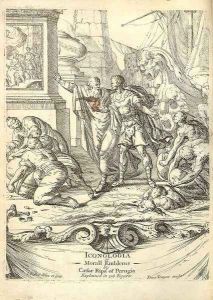Cesare Ripa Paintings
Cesare Ripa was an Italian iconographer and a theorist of the allegorical method, born around 1560 in Perugia, Italy. Little is known about his early life, including the precise year of his birth, which is often approximated. Ripa is most famous for his influential work 'Iconologia,' first published without illustrations in Rome in 1593. The book is a comprehensive collection of emblematic figures, each embodying abstract concepts, virtues, vices, passions, arts, and sciences. 'Iconologia' was not merely a book of emblems; it was a rich source of symbolic imagery, providing a reference for artists, poets, and theorists in the interpretation and representation of allegorical subjects.
Ripa's 'Iconologia' underwent numerous editions and was expanded and illustrated in its subsequent versions, notably the 1603 edition, which included woodcuts. The work's popularity spread throughout Europe, influencing art and literature far beyond Italy's borders. It was translated into several languages, including French, Dutch, and English, reflecting its significance in the cultural and intellectual exchanges of the 17th century.
Despite the profound impact of 'Iconologia' on the visual arts and emblem literature, details about Ripa's life remain scant. He is believed to have worked in the court of Cardinal Anton Maria Salviati in Rome, which might explain how he gained the knowledge and the inspiration for his book. Ripa's work is considered a crucial link between the Renaissance interest in emblematic symbolism and the Baroque era's allegorical representations. His approach to iconography, emphasizing the moral and philosophical implications of visual symbols, left a lasting legacy on the theory and practice of art.
Cesare Ripa's death in 1622 marked the end of an era that had seen the height of allegorical representation in art. While 'Iconologia' remains his most significant contribution, it stands as a testament to the enduring power of symbols in visual culture and their ability to convey complex ideas and emotions. Through his detailed descriptions and classifications of allegorical figures, Ripa provided a foundation for future generations to explore the intersection of art, literature, and philosophy.
